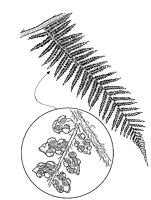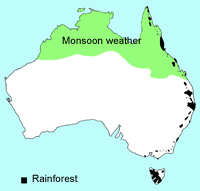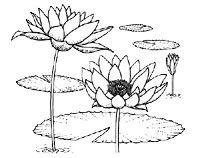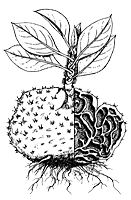The Display Glasshouse
The rainforest | Epiphytes | Forest floor | Plants from the Top End | Plants from outside Australia
Open 9 am – 4 pm daily
The Australian National Botanic Gardens collects plants from all parts of Australia, but not all of them can be grown outdoors in Canberra’s frosty climate.
The Gardens Display Glasshouse contains hundreds of species from sub-tropical and tropical Australia. There is a large collection of epiphytes (plants which grow on other plants for support), including ferns, ant plants and orchids. Other plants are from rainforests and monsoonal (wet season/dry season) areas, such as the Northern Territory.
Most of these plants were collected from the wild by staff or research associates of the Australian National Botanic Gardens.
Rainforest
As you walk into the glasshouse you’ll notice how much warmer and shadier it is inside than outside. Heavy shade cloth covers the roof and misting sprays keep the air and plants moist. Many of plants grown at this end of the glasshouse are from the understorey of rainforest areas. They grow naturally beneath the canopy of the taller trees. Their leaves are often fleshy or delicate — sheltered from the harsh drying effects of wind and sun.
Epiphytes - Orchids & Ferns
Epiphytes are plants that grow on the trunks and branches of other plants for support. Here plants are able to receive adequate sunlight and derive nutrients from decaying bark and falling leaves.
Some epiphytes grow high up on the top branches of trees. They get a lot of light, but wind often dries them out. These plants tend to have tough, fleshy leaves and spongy roots which can absorb water and resist drying. Other epiphytes grow lower down on the tree, in shadier conditions. Sometimes the leaves of these plants form ‘baskets’ that trap fallen leaves, providing nutrients to the plant as they rot.
Look out for these plants
1. Elkhorn and Staghorn Ferns
( Platycerium species)
These epiphytic ferns have two types of leaves. The large flat ‘nest leaves’ (both living and dead) at the base of the plant form a basket to catch leaf litter which falls from the tree canopy. The litter provides the fern with nutrients as it rots. The fertile fronds are narrower and more divided and have large patches of spores on the underside. [photo]
2. Bird’s-nest Ferns (Asplenium species)
There are several species of these striking epiphytes with tight whorls of overlapping fronds designed to trap falling leaf litter and guide water to the roots. [photo]
3. Tassel Ferns (Huperzia species)
These beautiful hanging and trailing plants have ancient origins — their giant tree-like ancestors covered the earth around 300 million years ago. [photo]
Plants of the Forest Floor
The glasshouse also displays many plants that grow in shade near or on the forest floor. These plants often have large leaves to catch the light and are often shallow rooted, as the soils in many rainforests are not very deep. Many ferns grow here.
Look out for these plants

5. Tree Ferns
(Cyathea and Dicksonia species)
Tree ferns abound in temperate rainforests and in other wet climates. The trunks of tree ferns often provide excellent growing conditions for epiphytes such as mosses, ferns and orchids. [photo]
6. Native Banana
(Musa banksii)
Australia has a native banana — closely related to commercially grown bananas. The native banana fruits are edible, but contain a lot of seeds. [photo]
7. King Fern
(Angiopteris evecta and Marattia species)
These fleshy species grow the largest fern fronds on earth — some reaching five meters in length. The plants we have on display are still recovering from transplantation, but will soon grow new fronds. [photo]
Plants from the Top End
 As
you wander away from the glasshouse door shade cloth no longer covers the roof,
creating hot and bright conditions. Many of the plants grown at this end of
the glasshouse occur in monsoon woodlands and grasslands where the climate has
distinct wet and dry seasons. Some plants die back during the dry season, others
lose most of their leaves. Some of the plants here were collected from Kakadu
National Park.
As
you wander away from the glasshouse door shade cloth no longer covers the roof,
creating hot and bright conditions. Many of the plants grown at this end of
the glasshouse occur in monsoon woodlands and grasslands where the climate has
distinct wet and dry seasons. Some plants die back during the dry season, others
lose most of their leaves. Some of the plants here were collected from Kakadu
National Park.

8. Water Lilies
(Nymphaea species)
When the wet season comes to Australia’s Top End huge areas of land are flooded. Water lilies are a common sight in these wetlands. [photo]
9. Climbing Fern (Lygodium species)
This fern climbs trees and scrambles over banks and rocks in open areas. Note the finger-like projections bearing spores on the fertile leaflets. Each climbing ‘branch’ is in fact just one leaf! [photo]
10. Oak-leaf or Basket Ferns (Drynaria species)
Distant cousins to the Staghorn and Elkhorn ferns, these epiphytes produce a tight basket of special dry oak-leaf like fronds and long graceful arching fronds that bear the spores. [photo]

11. Ant Plants
(Myrmecodia beccarii)
In nature, the swollen base of this plant is filled with hollows — home to an ants nest. The ants and the plants both benefit from this arrangement: the plant is excellent shelter, while the ants protect the plant from insect attack and bring in nutrients the plant can use.
12. Fox Tail Palm (Wodyetia bifurcata)
This beautiful palm grows only in the Melville Range in Northeastern Queensland. The plant has become quite popular in horticulture and at one stage illegal seed collectors posed a threat to the survival of the Fox Tail Palm in the wild.
13. Screw Palm (Pandanus gemmifer)
Screw palms occur throughout the monsoon areas of Northern Australia. They commonly grow on the banks of billabongs and streams. Special ‘prop roots’ grow from their stems as the plant gets taller and help support the plant.
Plants from Outside Australia
The Gardens collects Australian plants and studies their horticulture, biology and classification. Sometimes related plants from overseas need to be studied to give clues about how Australian plants evolved. There are many of these plants on display in the glasshouse — mostly orchids from South America or Asia.
Many of these overseas plants were confiscated from plants being illegally imported. Trade in plants stolen from their natural habitats is a major threat to their existence in the wild.
The labels of plants from overseas are marked with a yellow dot.
Glasshouse Facts
Temperature Range
Day optimum 26° C (max 30° C, min 21° C)
Night optimium 19° C (max 21° C, min 14° C)
Shade
Heavily shaded (rainforest area) 6,000 lux
No shade (monsoon area) 60,000 lux
Heating
Natural gas
Cooling
Passive cooling, automated side wall vents,
Evaporative coolers
Growing media
Main beds:
50% composted pine bark fines,
50% river sandEpiphyte tubes:
60% bark,
40% charcoal
(some contain 5% diatomaceous earth)
![Director of National Parks [logo]](../../../images/dnp_90px.gif)





